Peugeot 3008 Hybrid 4 2012 - RHD (UK. Australia) Service Manual
Manufacturer: PEUGEOT, Model Year: 2012, Model line: 3008 Hybrid 4, Model: Peugeot 3008 Hybrid 4 2012Pages: 284, PDF Size: 14.08 MB
Page 41 of 284
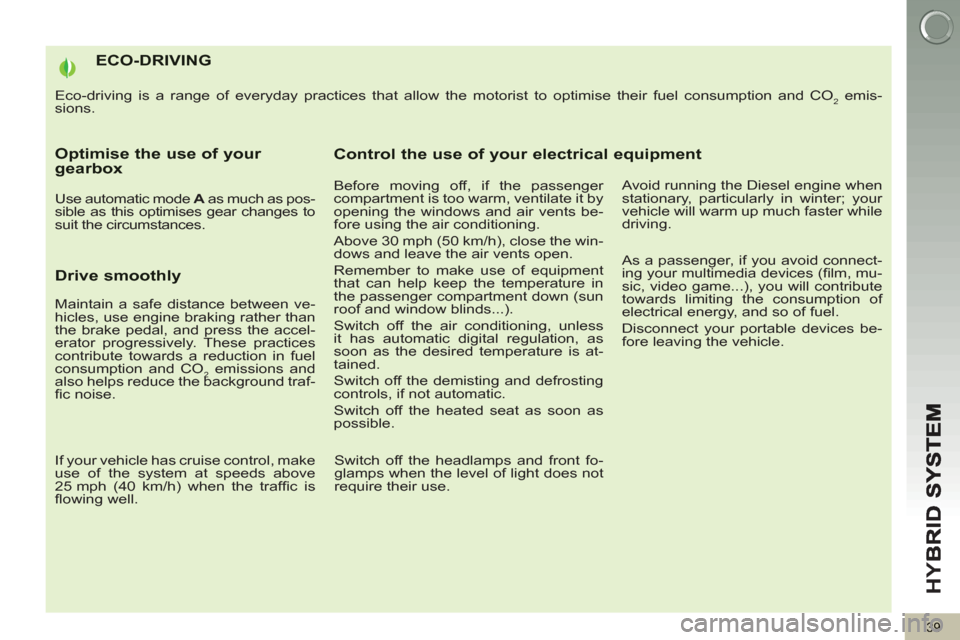
HY
B
39
ECO-DRIVING
Eco-driving is a range of everyday practices that allow the motorist to optimise their fuel consumption and CO2 emis-
sions.
Optimise the use of your gearbox
Use automatic mode A
as much as pos-
sible as this optimises gear changes to
suit the circumstances.
Drive smoothly
If your vehicle has cruise control, make
use of the system at speeds above
25 mph (40 km/h) when the traffi c is
fl owing well.
Control the use of your electrical equipment
Before moving off, if the passenger
compartment is too warm, ventilate it by
opening the windows and air vents be-
fore using the air conditioning.
Above 30 mph (50 km/h), close the win-
dows and leave the air vents open.
Remember to make use of equipment
that can help keep the temperature in
the passenger compartment down (sun
roof and window blinds...).
Switch off the air conditioning, unless
it has automatic digital regulation, as
soon as the desired temperature is at-
tained.
Switch off the demisting and defrosting
controls, if not automatic.
Switch off the heated seat as soon as
possible.
Switch off the headlamps and front fo-
glamps when the level of light does not
require their use.
Avoid running the Diesel engine when
stationary, particularly in winter; your
vehicle will warm up much faster while
driving.
As a passenger, if you avoid connect-
ing your multimedia devices (fi lm, mu-
sic, video game...), you will contribute
towards limiting the consumption of
electrical energy, and so of fuel.
Disconnect your portable devices be-
fore leaving the vehicle.
Maintain a safe distance between ve-
hicles, use engine braking rather than
the brake pedal, and press the accel-
erator progressively. These practices
contribute towards a reduction in fuel
consumption and CO
2 emissions and
also helps reduce the background traf-
fi c noise.
Page 42 of 284
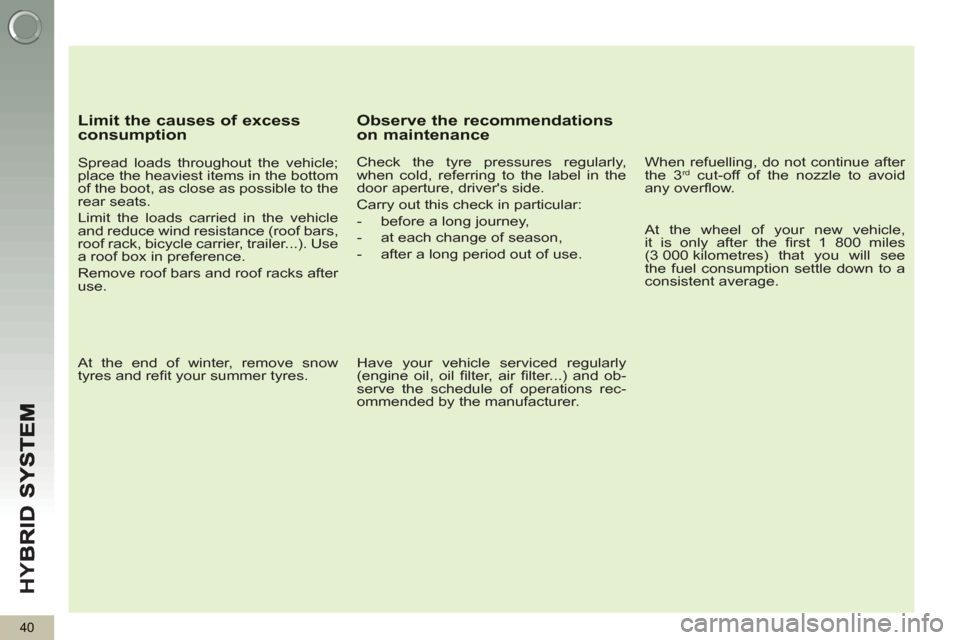
HY
B
40
Limit the causes of excess consumption
Spread loads throughout the vehicle;
place the heaviest items in the bottom
of the boot, as close as possible to the
rear seats.
Limit the loads carried in the vehicle
and reduce wind resistance (roof bars,
roof rack, bicycle carrier, trailer...). Use
a roof box in preference.
Remove roof bars and roof racks after
use.
At the end of winter, remove snow
tyres and refi t your summer tyres.
Observe the recommendationson maintenance
Check the tyre pressures regularly,
when cold, referring to the label in the
door aperture, driver's side.
Carry out this check in particular:
- before a long journey,
- at each change of season,
- after a long period out of use.
Have your vehicle serviced regularly
(engine oil, oil fi lter, air fi lter...) and ob-
serve the schedule of operations rec-
ommended by the manufacturer.
When refuelling, do not continue after
the 3 rd cut-off of the nozzle to avoid
any overfl ow.
At the wheel of your new vehicle,
it is only after the fi rst 1 800 miles
(3 000 kilometres) that you will see
the fuel consumption settle down to a
consistent average.
Page 43 of 284
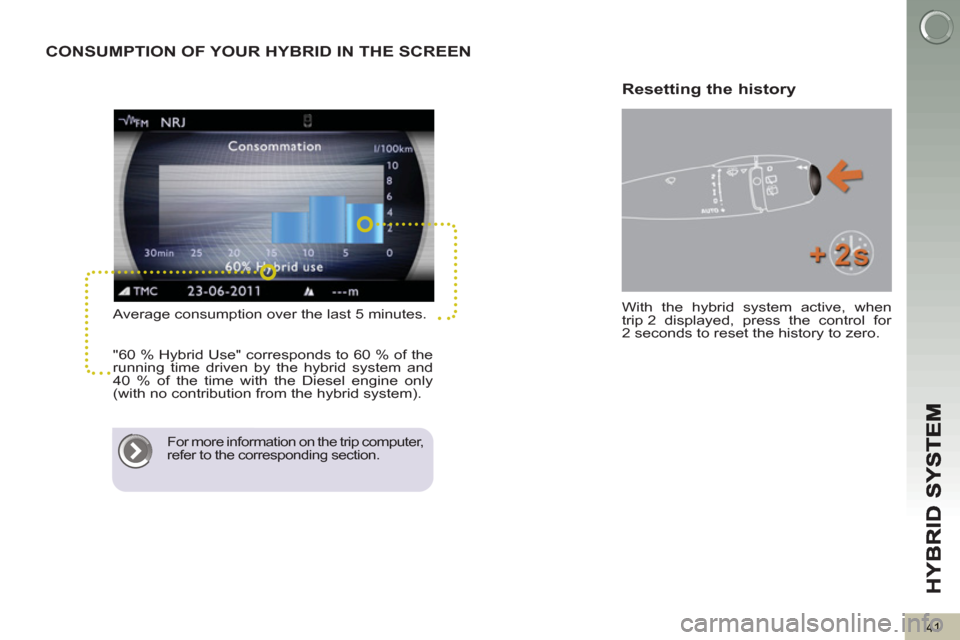
41
CONSUMPTION OF YOUR HYBRID IN THE SCREEN
Average consumption over the last 5 minutes.
"60 % Hybrid Use" corresponds to 60 % of the
running time driven by the hybrid system and
40 % of the time with the Diesel engine only
(with no contribution from the hybrid system).
For more information on the trip computer,
refer to the corresponding section.
With the hybrid system active, when
trip 2 displayed, press the control for
2 seconds to reset the history to zero.
Resetting the history
Page 44 of 284
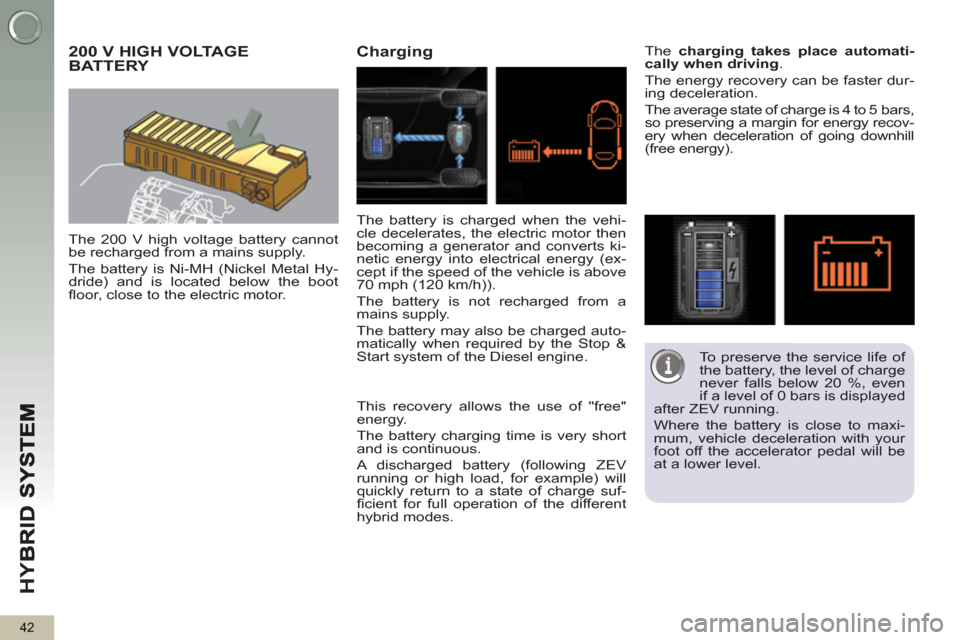
HY
B
42
200 V HIGH VOLTAGEBATTERY
The 200 V high voltage battery cannot
be recharged from a mains supply.
The battery is Ni-MH (Nickel Metal Hy-
dride) and is located below the boot
fl oor, close to the electric motor.
Charging
The charging takes place automati-
cally when driving
.
The energy recovery can be faster dur-
ing deceleration.
The average state of charge is 4 to 5 bars,
so preserving a margin for energy recov-
ery when deceleration of going downhill
(free energy).
The battery is charged when the vehi-
cle decelerates, the electric motor then
becoming a generator and converts ki-
netic energy into electrical energy (ex-
cept if the speed of the vehicle is above
70 mph (120 km/h)).
The battery is not recharged from a
mains supply.
The battery may also be charged auto-
matically when required by the Stop &
Start system of the Diesel engine.
To preserve the service life of
the battery, the level of charge
never falls below 20 %, even
if a level of 0 bars is displayed
after ZEV running.
Where the battery is close to maxi-
mum, vehicle deceleration with your
foot off the accelerator pedal will be
at a lower level.
This recovery allows the use of "free"
energy.
The battery charging time is very short
and is continuous.
A discharged battery (following ZEV
running or high load, for example) will
quickly return to a state of charge suf-
fi cient for full operation of the different
hybrid modes.
Page 45 of 284
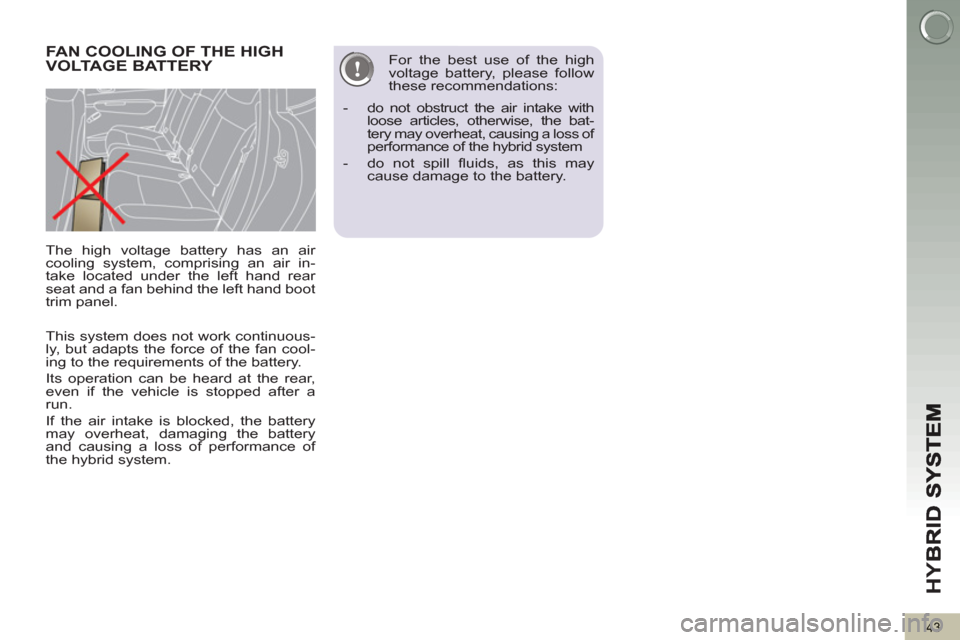
HY
B
43
This system does not work continuous-
ly, but adapts the force of the fan cool-
ing to the requirements of the battery.
Its operation can be heard at the rear,
even if the vehicle is stopped after a
run.
If the air intake is blocked, the battery
may overheat, damaging the battery
and causing a loss of performance of
the hybrid system.
FAN COOLING OF THE HIGHVOLTAGE BATTERY
For the best use of the high
voltage battery, please follow
these recommendations:
- do not obstruct the air intake with
loose articles, otherwise, the bat-
tery may overheat, causing a loss of
performance of the hybrid system
- do not spill fl uids, as this may
cause damage to the battery.
The high voltage battery has an air
cooling system, comprising an air in-
take located under the left hand rear
seat and a fan behind the left hand boot
trim panel.
Page 46 of 284
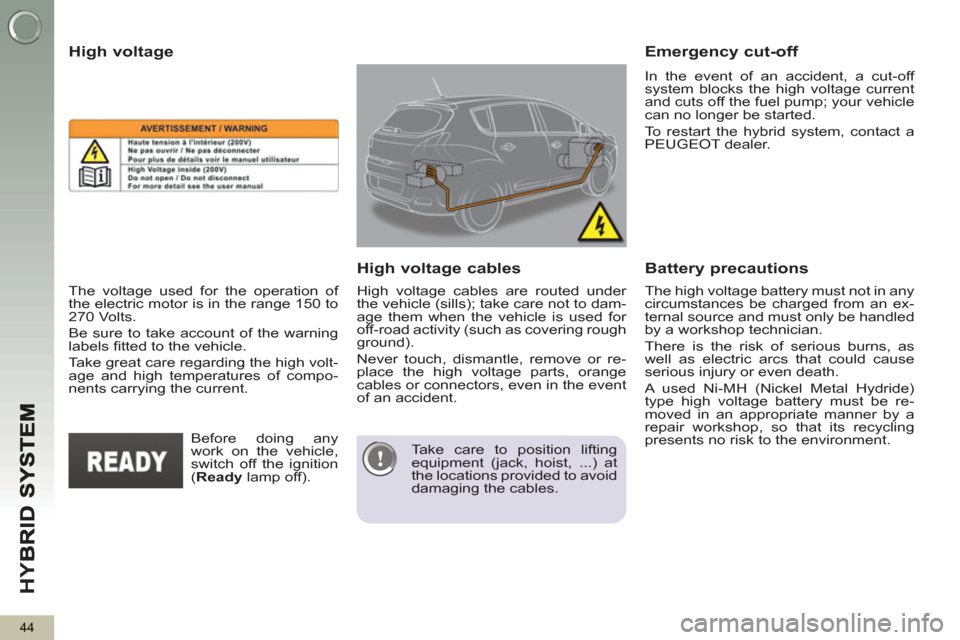
HY
B
44
The high voltage battery must not in any
circumstances be charged from an ex-
ternal source and must only be handled
by a workshop technician.
There is the risk of serious burns, as
well as electric arcs that could cause
serious injury or even death.
A used Ni-MH (Nickel Metal Hydride)
type high voltage battery must be re-
moved in an appropriate manner by a
repair workshop, so that its recycling
presents no risk to the environment.
High voltage
The voltage used for the operation of
the electric motor is in the range 150 to
270 Volts.
Be sure to take account of the warning
labels fi tted to the vehicle.
Take great care regarding the high volt-
age and high temperatures of compo-
nents carrying the current.
Emergency cut-off
High voltage cables are routed under
the vehicle (sills); take care not to dam-
age them when the vehicle is used for
off-road activity (such as covering rough
ground).
Never touch, dismantle, remove or re-
place the high voltage parts, orange
cables or connectors, even in the event
of an accident.
Before doing any
work on the vehicle,
switch off the ignition
( Ready
lamp off).
Battery precautions High voltage cables
Take care to position lifting
equipment (jack, hoist, ...) at
the locations provided to avoid
damaging the cables.
In the event of an accident, a cut-off
system blocks the high voltage current
and cuts off the fuel pump; your vehicle
can no longer be started.
To restart the hybrid system, contact a
PEUGEOT dealer.
Page 47 of 284
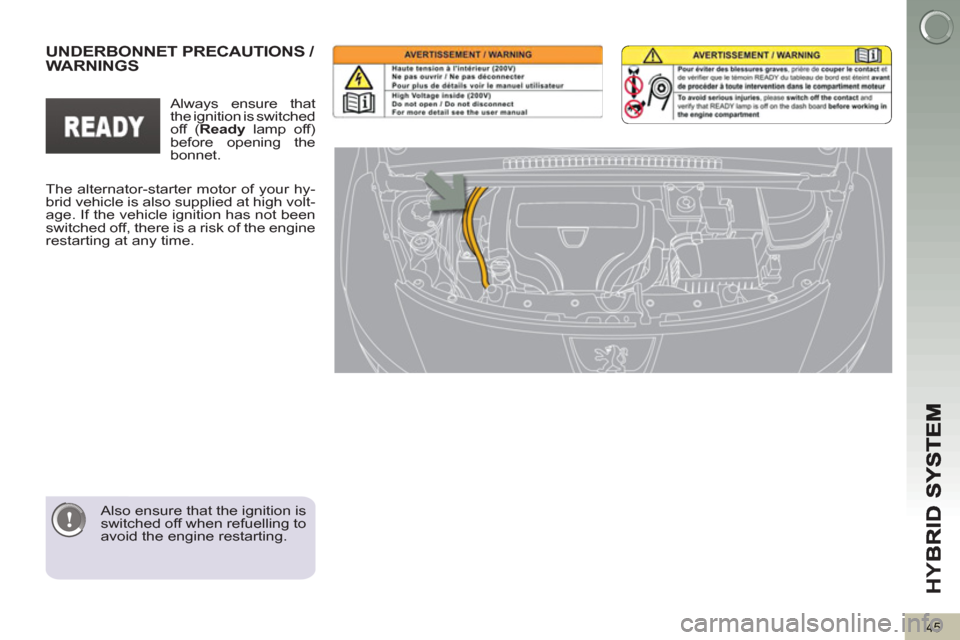
HY
B
45
Also ensure that the ignition is
switched off when refuelling to
avoid the engine restarting.
UNDERBONNET PRECAUTIONS /
WARNINGS
The alternator-starter motor of your hy-
brid vehicle is also supplied at high volt-
age. If the vehicle ignition has not been
switched off, there is a risk of the engine
restarting at any time.
Always ensure that
the ignition is switched
off ( Ready
lamp off)
before opening the
bonnet.
Page 48 of 284
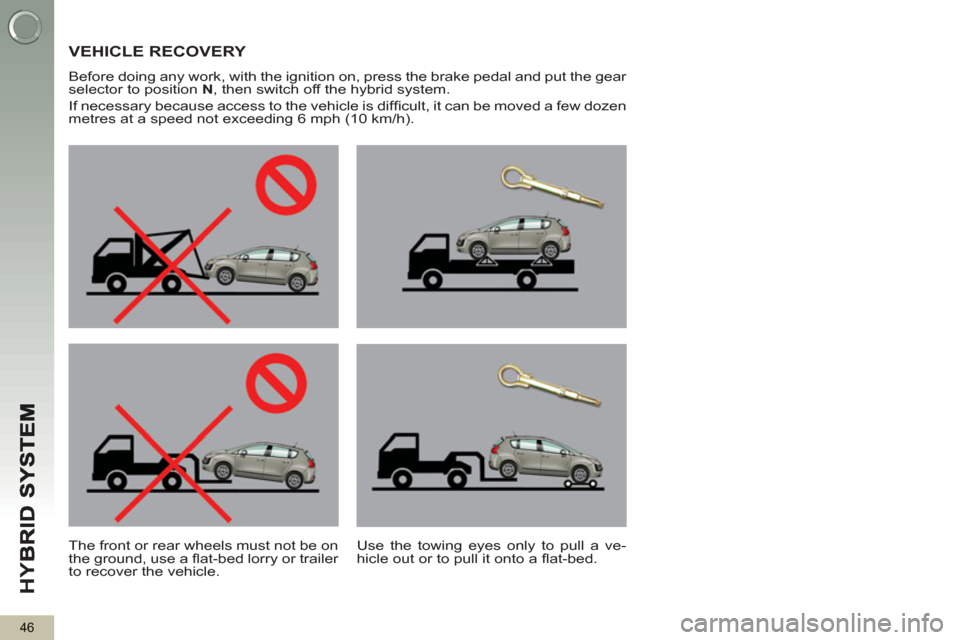
HY
B
46
VEHICLE RECOVERY
Before doing any work, with the ignition on, press the brake pedal and put the gear
selector to position N
, then switch off the hybrid system.
If necessary because access to the vehicle is diffi cult, it can be moved a few dozen
metres at a speed not exceeding 6 mph (10 km/h).
The front or rear wheels must not be on
the ground, use a fl at-bed lorry or trailer
to recover the vehicle.
Use the towing eyes only to pull a ve-
hicle out or to pull it onto a fl at-bed.
Page 49 of 284
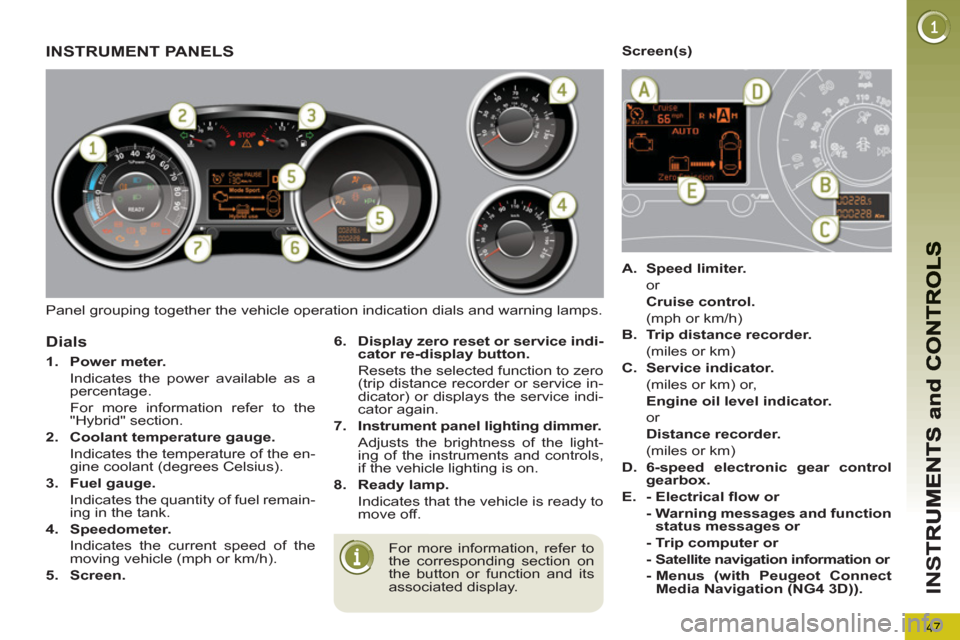
47
IN
S
Panel grouping together the vehicle operation indication dials and warning lamps.
INSTRUMENT PANELS
For more information, refer to
the corresponding section on
the button or function and its
associated display.
Dials
6.
Display zero reset or service indi-
cator re-display button.
Resets the selected function to zero
(trip distance recorder or service in-
dicator) or displays the service indi-
cator again.
7.
Instrument panel lighting dimmer.
Adjusts the brightness of the light-
ing of the instruments and controls,
if the vehicle lighting is on.
8.
Ready lamp.
Indicates that the vehicle is ready to
move off.
1.
Power meter.
Indicates the power available as a
percentage .
For more information refer to the
"Hybrid" section.
2.
Coolant temperature gauge.
Indicates the temperature of the en-
gine coolant (degrees Celsius).
3.
Fuel gauge.
Indicates the quantity of fuel remain-
ing in the tank.
4.
Speedometer.
Indicates the current speed of the
moving vehicle (mph or km/h).
5.
Screen.
Screen(s)
A.
Speed limiter.
or
Cruise control.
(mph or km/h)
B.
Trip distance recorder.
(miles or km)
C.
Service indicator.
(miles or km) or,
Engine oil level indicator.
or
Distance recorder.
(miles or km)
D.
6-speed electronic gear control
gearbox.
E.
- Electrical fl ow or
- Warning messages and function
status messages
or
- Trip computer or
- Satellite navigation information or
- Menus (with Peugeot Connect
Media Navigation (NG4 3D)).
Page 50 of 284
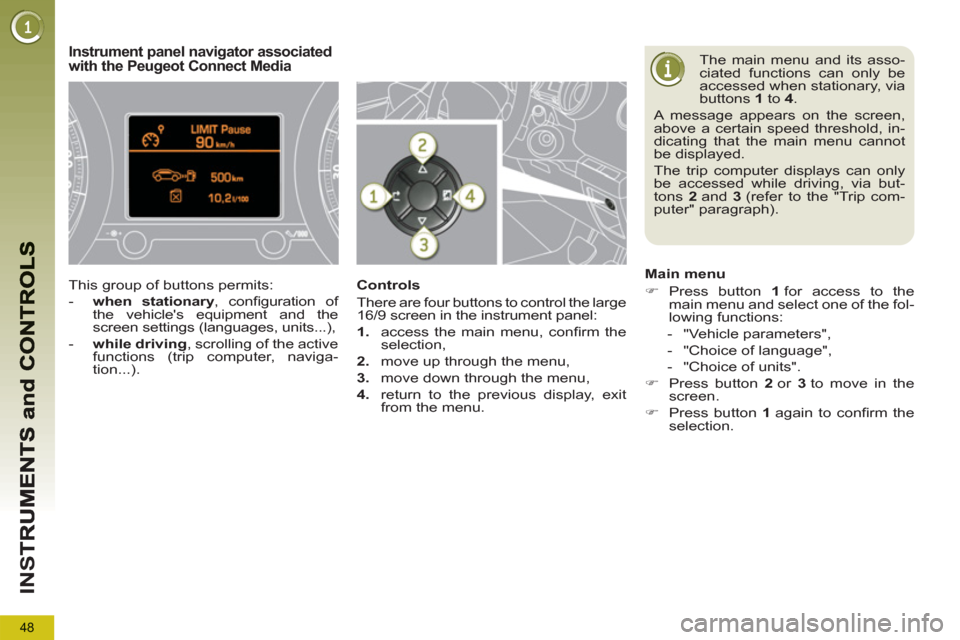
48
IN
S
The main menu and its asso-
ciated functions can only be
accessed when stationary, via
buttons 1
to 4
.
A message appears on the screen,
above a certain speed threshold, in-
dicating that the main menu cannot
be displayed.
The trip computer displays can only
be accessed while driving, via but-
tons 2
and 3
(refer to the "Trip com-
puter" paragraph).
Main menu
�)
Press button 1
for access to the
main menu and select one of the fol-
lowing functions:
- "Vehicle parameters",
- "Choice of language",
- "Choice of units".
�)
Press button 2
or 3
to move in the
screen.
�)
Press button 1
again to confi rm the
selection.
Instrument panel navigator associated
with the Peugeot Connect Media
This group of buttons permits:
- when stationary
, confi guration of
the vehicle's equipment and the
screen settings (languages, units...),
- while driving
, scrolling of the active
functions (trip computer, naviga-
tion...).
Controls
There are four buttons to control the large
16/9 screen in the instrument panel:
1.
access the main menu, confi rm the
selection,
2.
move up through the menu,
3.
move down through the menu,
4.
return to the previous display, exit
from the menu.